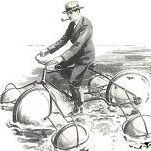You will be absolutely fine.
I would imagine you will be on your way somewhere between 3:30 and 4:00, leaving plenty of time for a pleasant trip up into Birmingham.
If you are looking to eat on board then I suggest it is well worth heading beyond the first moorings - there is a sharp left turn when you get into Birmingham (Mailbox Turn) and then the moorings start on your left. Beyond that first set of moorings is a narrows (it used to be a stop lock), then a long bridge (Broad Street Tunnel) and shortly afterwards a roundabout (yes, really, but you don't have to treat it is such in terms of which side you pass). Beyond there are nice moorings on both sides and if you go on a few hundred feet it gets a bit quieter as there are nightclubs and pubs near the roundabout. It is worth walking back to have a look at it lit up at night as it's quite a good atmosphere but mooring down nearer Vincent Street Bridge is much quieter.
You will need to turn round in the morning and go back to the roundabout and turn left. There are various arms along the main line so turning in one of those is the easy option. You will probably find this a bit tricky, and may well make a mess of it, but don't worry about it, everyone does at first! One trick is to put someone on the bank on the side opposite the entrance, with the stern rope. Point the bow down the entrance and have the person on the bank pull the stern round. This is -way- easier than trying to get the boat to do it through a combination of forward and reverse, although assisting the person pulling by using the engine can help, and can also give you a sense of how the boat is going to behave.
Locks. You are best off working out your own system, but here is a starter for ten to give you an idea.
You are starting off going downhill. Person A steers - they stay on the boat. Person B goes up to the lock, unlocks any handcuffs which stop the paddles opening (you will have a handcuff key - make sure you have two on the boat!), if the lock is with you (level is the same as the boat going in) they just open the gate. If it is against you, they check nobody is about to come in from the other direction and assuming not, they open first paddle, then cross over and open the other paddle. Once the lock is level they close the paddle on the offside, then cross back to the gate side, open the gate and lower the paddle (do it that way round as there is time to lower the paddle while the boat comes in, and it is also less hard work to push the gate when the paddle is open as it decreases the water resistance). The lock is now ready for the boat to come in. Person B then walks to the other end of the lock, towpath side, and waits, ready to open the paddle when the boat comes in. Person C then turns up, having walked down, arriving before the boat. They stand by the open gate, ready to close it when the boat comes in. Person D arrives around the same time as the boat, walks down to the offside gate at the lower end and stands ready to open the paddle. The boat comes in, C closes the gate, B and D open the paddles. As soon as their paddle is open, B heads on to the next lock and sets it up as before; C goes and stands by the paddle that B opened. When the level matches, C and D open the gates and the boat starts moving out while C and D lower the paddles and re-lock any handcuff locks. Once the boat is clear, C and D close the gates and C walks on. D walks to the other end of the lock and locks up the handcuff locks at the top end, then walks on to the next lock. Repeat.
Not sure if the above makes any sense whatsoever, and if not it doesn't matter - there are millions of different ways of doing this and you will work it out, but the aim is to give an idea of an efficient way of working through a flight of locks. Key points to note in the above - not all locks have handcuff locks on but some do; not all of them work so sometimes you can't unlock it and have to work with only one paddle which is a bit slower and sometimes you can't re-lock it, so just leave it unlocked. When there are handcuff keys in place, the above working pattern has all of them unlocked while the boat is in the lock. It is very unlikely that anything will go wrong if you take care and watch what is happening, but if it does, the ability to open and close paddles quickly can be important so I prefer to leave them unlocked until the gates are open.
It does not require tremendous strength, although some gates can be a bit awkward. My daughters (13 and 15) working Brades bottom lock on the BCN earlier this year.
Alec
p.s. but you have five people - what about Person E - Tea!!!


















